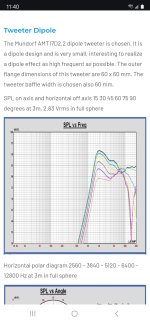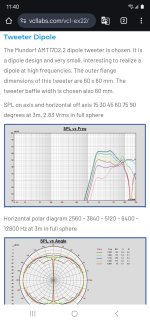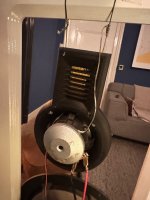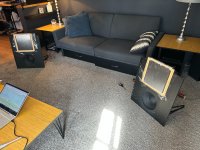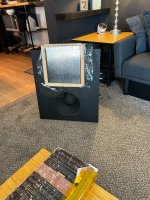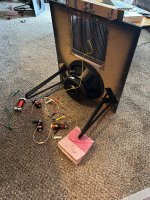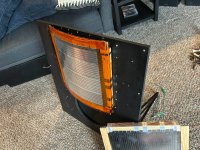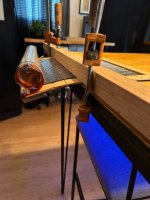Hi Vitalica,
Paul's work are professional, beautiful designs. What you have built inspires me. I have built, in the past couple years, an OB using stone and a Lii S-10 and a Decware design, Headwrecker folded horn using Lii P-10. I am attracted to the 15", especially the dual woofer design.
Paul's work are professional, beautiful designs. What you have built inspires me. I have built, in the past couple years, an OB using stone and a Lii S-10 and a Decware design, Headwrecker folded horn using Lii P-10. I am attracted to the 15", especially the dual woofer design.
Last edited:
Thank you vitalica.This project was inspired by here: www.vcllabs.com.
Enjoy your build

Regards
George
I noticed that they use mundorf amt17d2.2 in few of their builds. I never used this amt tweeter, i got original ess and few daytons.This project was inspired by here: www.vcllabs.com. Paul was very friendly and helped me with all the necessary information and especially with all the information related to all the minidsp Flex settings. I can say that of all my OB projects this is the most successful. I simply can't get enough of listening to song after song. I'm happy that I discovered Paul's site.
Interestingly that mundorf fr response looks rather weird. Lots of signal at 2kHz, then it drops down.
Anybody here has any personal experience with this amt tweeter?
Attachments
Indeed Mundorf AMT17D2.2 shows a high Q SPL peak around 1700 Hz. We use crossover at 2500 Hz, LR4 and other high order filtering. In fact, it is rather low for this tweeter, but it performs very well in the VCL DI-215-W speaker. In DSP a high Q notch is applied around 1700 Hz. We also tried an LR2 filter at 3500 Hz, also performing very well. We did choose this AMT tweeter because it is very small, only 60 mm wide, in a way it shows a good dipole behavior up to about 6 kHz. Remark that the Mundorf AMT25D1.1 also show a SPL peak, but lower, around 1200 Hz. AMT25 has a higher diaphragm with some more vertical beaming and less room power. Till now we haven't tried out the AMT25.I noticed that they use mundorf amt17d2.2 in few of their builds. I never used this amt tweeter, i got original ess and few daytons.
Interestingly that mundorf fr response looks rather weird. Lots of signal at 2kHz, then it drops down.
Anybody here has any personal experience with this amt tweeter?
just finished and adjusted

two 12 br70, ess heil in OB WG (designed using ath, thank's Marcel one more time), and sica 8 fe 2.5 cp
below are freq responses on mlp,

ess wg sonogram

two subs in progress to help with bottom freqs and give some physical thump when wished
two 12 br70, ess heil in OB WG (designed using ath, thank's Marcel one more time), and sica 8 fe 2.5 cp
below are freq responses on mlp,
ess wg sonogram
two subs in progress to help with bottom freqs and give some physical thump when wished
it can even go quiet loud with not much distortion - mine is 1st order crossed around 4k i think to a 10f 8424 - i 3d printed some kind of waveguide on both sidesI noticed that they use mundorf amt17d2.2 in few of their builds. I never used this amt tweeter, i got original ess and few daytons.
Interestingly that mundorf fr response looks rather weird. Lots of signal at 2kHz, then it drops down.
Anybody here has any personal experience with this amt tweeter?
Attachments
I've basically only had the 18" at 80 or 100 cutoff. Heavy eq starting from 20 and light eq on the 12" JBL midbass going 100-500 seems to sound very good to my ears.Hi,
Did you try a 100 hz cut off and reduce the 18" to 15" or 12" ?
So you U framed the 18" and it was okay then ?
I'm very happy with the bass to be honest. I actually have no issues with not loading the room as my wife is always asleep above me. I'm not wildly picky about super deep bass, I care more about quality around 100. That said, it goes pretty deep.
I haven't tried wings yet. But I will be.
Looking for advice on choosing a tweeter I want to try as an up firing "ambience" tweeter. I like the idea. I have good highs but I wouldn't mind a touch of sparkle and air.
So...I feel like I have no idea what to look for in such a tweeter. Hoping to hear any thoughts.
Soft dome? Am I looking for horizontal dispersion or does that not actually matter in this sitch?
I'm not really budget focused, any suggestions are welcome. Oh, my crossover allows for 12.5k or 18k (or lower but I expect to be up there).
So...I feel like I have no idea what to look for in such a tweeter. Hoping to hear any thoughts.
Soft dome? Am I looking for horizontal dispersion or does that not actually matter in this sitch?
I'm not really budget focused, any suggestions are welcome. Oh, my crossover allows for 12.5k or 18k (or lower but I expect to be up there).
I've posted new DSP file and hardware updates to the Bitches Brew live edge Open Baffle project HERE.

some ugly prototype fun. larger home brew planer from 300 hz up (diaphragm resonance at 50 hz) , 96db pro woofer on bottom. Pro woofer gives a flat response to about 40 hz once the crossover attached (13mH/100uF) with a 20 ohm resistor across the cap. Trap circuit on planer flattens on axsis response and gives +- 2db from 300Hz to 20Khz. Small baffle about 22 inch wide. x 24 tall. Small listening window but outstanding imaging as typical with large area flat planers or stats. Much better overall sonics than when woofer taken to 500hz as necessary with the smaller and higher diaphragm resonance commercial planers. I would say bang for buck doesn't get much higher than this. Planer traces are tapped in middle so can turn into a concentric mid/tweet eventually but for now Steve Ray is in the room
Attachments
Last edited:
a bit more on the ugly girl......
reconfigured the taps on planer traces so it has a concentric tweeter mid section. Results were quite good. Wide listening window in horizontal plane. . More layed back sound in a good way. Now speakers dont have to be toed in much at all. Image stable BUT quite not as stunningly present as running planer w/o tweet. Not sure if that isnt just FR tailoring ha. Found myself turning it up louder btw with the concentric tweet.
I have had tweets to side of planer btw and the concentric beats it by a mile. No lobbing issues seem to be a big deal.
What really surprised me is this arraignments ability to do 6db crossovers well with no apparent problems. 12 db sometimes has sound collapse into speaker but 6 completely disappears and has a quality Im not sure I can explained. Just better. The woofer is the weak link in this one. Maybe a crossover that starts as 6db gradually increasing to 12db would be a bit better. As in big inductor small cap
reconfigured the taps on planer traces so it has a concentric tweeter mid section. Results were quite good. Wide listening window in horizontal plane. . More layed back sound in a good way. Now speakers dont have to be toed in much at all. Image stable BUT quite not as stunningly present as running planer w/o tweet. Not sure if that isnt just FR tailoring ha. Found myself turning it up louder btw with the concentric tweet.
I have had tweets to side of planer btw and the concentric beats it by a mile. No lobbing issues seem to be a big deal.
What really surprised me is this arraignments ability to do 6db crossovers well with no apparent problems. 12 db sometimes has sound collapse into speaker but 6 completely disappears and has a quality Im not sure I can explained. Just better. The woofer is the weak link in this one. Maybe a crossover that starts as 6db gradually increasing to 12db would be a bit better. As in big inductor small cap
just a simple single ended planer single trace 12 micron thick foil . Nothing new here really. This size about 10 x 10 inces came out to about 3 ohms and arond 90 db sens once it was leveled out with a trap or rake circuit. the trap I used was .65mH/2uf/20 ohm.
Ive done a lot of testing and The important detail is basically the width of the neo magnets wich are 5mm here. Then about 3mm space between them. The reason is to reduce the size of the porlly driven areas of diaphragm so that the ringing is reduced to reasonable level.
Ok so what does that mean? In a single ended magnet the flux lines directly over the magnets are not parallel to the foil traces. So area of diaphragm directly over the magnets is not driven as well as areas directly over the spaces between the magnets. If ya use larger wider magnets and spaces ya end up with wider areas of the diaphragm that are not driven all that well and there is ringing in those areas. This is fine if the diaphragm is only used as a woofer as you often see with commercial units BUT as a full range it all gets better if you use much smaller magnets and thus much smaller areas that aren't driven well.
Even this one still has some ringing but its small and all gone in less than a millisecond.
As far as the taps for concentric tweeter its simply as said just tap into the traces in center and have a seperate crossover filter feed that part. I used about a 1.5 inch wide section in middle.
Magents glued to perforated steel (63% open area BUT anything with at least a 40% will do) with super glue. Just use a straight edge to align mags and a 1/8 in rod or spacer between rows.
Foil was attached to a plate of glass ( i used a bathroom mirror) with very light spray of Super 77 adhesive, then all traces cut using a fabric cut wheel. Then spray 2 light coats of Super 77 over that, roll the 12 micron polyester film over it all and rub it down well. Then just lift it all off and you have your diaphragm.
I tension the diaphragm on the same mirror surface (after ya clean all the excess glue off) using scotch tape all around the edges. Just get it nice and tight and use tapes about every 2-3 inches all around edges.
The "frame" on the magnet structure has double sided tape around edges then just lay down over the tensioned film and press hard around edges. Remove tapes and lift the whole thing off.
The "frame" wasnt an actual frame but simply paint stering sticks from the paint store super glued down onto the perforated steel plate. This gave about 2mm space between magnets and diaphragm
VERY crude BUT its a proto ha
Look close at pics to see crude attachments for foil and wires
BTW as for connections to foil. There are fluxes to solder BUT what I do is put a dab of motor oil or any oil on foil and sand very lightly with 600 grit sand paper. This gets the difficult aluminum oxide off while keeping foil from oxygen. Then clean off the grit with a clean rag diped in oil. Idea is to never let the foil see oxygen. It will immediately form an invisible oxide that plays hell with mechanical connections. Now ya have a clean surface on the foil an can just run a screw into the wood(see big block of oak I used in pics) and use a washer so not to crush and cut foil when tightening. This is a short term connection for prpto work and solder is a long term method
Also I have used the exotic fluxes to solder foil BUT another method is simply solder under oil. Yep it does work but ya simply have to scrape the foil lightly with a sharp solder tip as ya solder. A bit of a trick to get good at but the oil keeps the foil from oxidizing and as you scrape fresh aluminum the solder will aloy to it.
Ive done a lot of testing and The important detail is basically the width of the neo magnets wich are 5mm here. Then about 3mm space between them. The reason is to reduce the size of the porlly driven areas of diaphragm so that the ringing is reduced to reasonable level.
Ok so what does that mean? In a single ended magnet the flux lines directly over the magnets are not parallel to the foil traces. So area of diaphragm directly over the magnets is not driven as well as areas directly over the spaces between the magnets. If ya use larger wider magnets and spaces ya end up with wider areas of the diaphragm that are not driven all that well and there is ringing in those areas. This is fine if the diaphragm is only used as a woofer as you often see with commercial units BUT as a full range it all gets better if you use much smaller magnets and thus much smaller areas that aren't driven well.
Even this one still has some ringing but its small and all gone in less than a millisecond.
As far as the taps for concentric tweeter its simply as said just tap into the traces in center and have a seperate crossover filter feed that part. I used about a 1.5 inch wide section in middle.
Magents glued to perforated steel (63% open area BUT anything with at least a 40% will do) with super glue. Just use a straight edge to align mags and a 1/8 in rod or spacer between rows.
Foil was attached to a plate of glass ( i used a bathroom mirror) with very light spray of Super 77 adhesive, then all traces cut using a fabric cut wheel. Then spray 2 light coats of Super 77 over that, roll the 12 micron polyester film over it all and rub it down well. Then just lift it all off and you have your diaphragm.
I tension the diaphragm on the same mirror surface (after ya clean all the excess glue off) using scotch tape all around the edges. Just get it nice and tight and use tapes about every 2-3 inches all around edges.
The "frame" on the magnet structure has double sided tape around edges then just lay down over the tensioned film and press hard around edges. Remove tapes and lift the whole thing off.
The "frame" wasnt an actual frame but simply paint stering sticks from the paint store super glued down onto the perforated steel plate. This gave about 2mm space between magnets and diaphragm
VERY crude BUT its a proto ha
Look close at pics to see crude attachments for foil and wires
BTW as for connections to foil. There are fluxes to solder BUT what I do is put a dab of motor oil or any oil on foil and sand very lightly with 600 grit sand paper. This gets the difficult aluminum oxide off while keeping foil from oxygen. Then clean off the grit with a clean rag diped in oil. Idea is to never let the foil see oxygen. It will immediately form an invisible oxide that plays hell with mechanical connections. Now ya have a clean surface on the foil an can just run a screw into the wood(see big block of oak I used in pics) and use a washer so not to crush and cut foil when tightening. This is a short term connection for prpto work and solder is a long term method
Also I have used the exotic fluxes to solder foil BUT another method is simply solder under oil. Yep it does work but ya simply have to scrape the foil lightly with a sharp solder tip as ya solder. A bit of a trick to get good at but the oil keeps the foil from oxidizing and as you scrape fresh aluminum the solder will aloy to it.
Last edited:
BTW can anyone recommend a good open baffle woofer please.
Presently using a parts express pro 12inch 96db sens. It works ok to about 100 db in open baffle at seat BUT looking for another 4-6 db head room and a lower Fs. 40hz would be ok
The PE 12 pro has Xmax around 5mm and I suspect a 15 at 94+db will likley have same Xmax and may be enough??
BUT if there is a reasonable priced woofer with a 10mm X max that would be great. If not then I guess the 15 will do. Not really interested in using two woofers as I want to keep speaker size down.
Presently using a parts express pro 12inch 96db sens. It works ok to about 100 db in open baffle at seat BUT looking for another 4-6 db head room and a lower Fs. 40hz would be ok
The PE 12 pro has Xmax around 5mm and I suspect a 15 at 94+db will likley have same Xmax and may be enough??
BUT if there is a reasonable priced woofer with a 10mm X max that would be great. If not then I guess the 15 will do. Not really interested in using two woofers as I want to keep speaker size down.
Thank you lowmass for the extended description !just a simple single ended planer......
George
The ugly girl grew some curves .😉
Testing/listening of the flat panel planer is done. As much as I liked them configured with the concentric tweeter the single driver flat panel is superior. The head in a vise thing is hard to live with but I certainly see what all the fuss is about with big flat panels.
That said the units are now reconfigured as Curved panels. The protos were designed such that the diaphragms can be pealed off, magnet structures curve radius changed and re-diaphragmed in minuets. Hope of course is to keep as much of the flat panels superior imaging and dynamics BUT with a bit wider listening window. Im sure there will be a compromise somewhere ha
Testing/listening of the flat panel planer is done. As much as I liked them configured with the concentric tweeter the single driver flat panel is superior. The head in a vise thing is hard to live with but I certainly see what all the fuss is about with big flat panels.
That said the units are now reconfigured as Curved panels. The protos were designed such that the diaphragms can be pealed off, magnet structures curve radius changed and re-diaphragmed in minuets. Hope of course is to keep as much of the flat panels superior imaging and dynamics BUT with a bit wider listening window. Im sure there will be a compromise somewhere ha
Attachments
- Home
- Loudspeakers
- Multi-Way
- Ultimate Open Baffle Gallery
